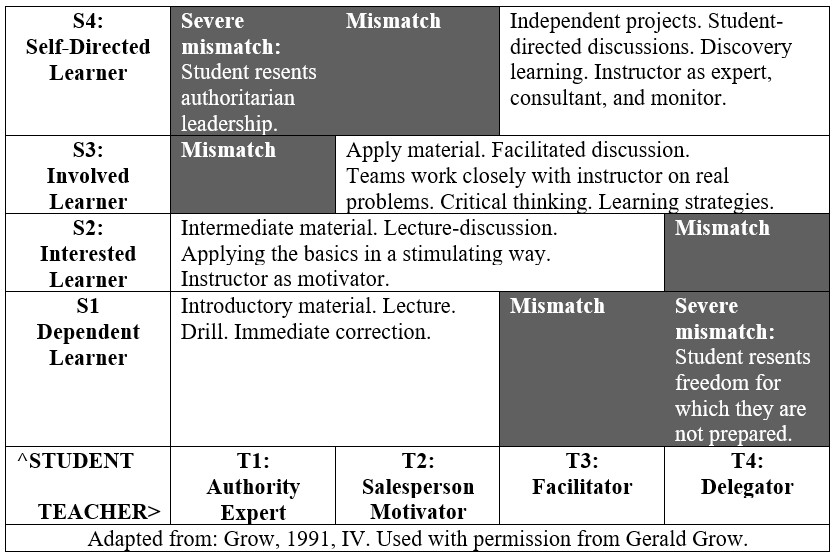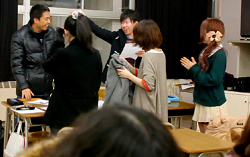Integrating contingency leadership models with learning team processes may provide a partial answer to help faculty build strategies for supporting individual student performance, satisfaction, and persistence. An exploration of contingency leadership models leads to the discovery of flexible classroom management strategies. These strategies can enable faculty in adult higher education to develop dynamic teaching methods that meet individual students' needs in a functionally diverse collaborative learning environment.
Developing flexibility to meet the needs of the situation
The contingency leadership models taught in management courses provide faculty with some insights into adjusting teaching styles to meet individual learners' needs. Using a contingency approach, leaders adapt their leadership style to match the situation. For example, in Hersey and Blanchard's [1] Situational Leadership Model, a leader increases or decreases control depending on the readiness of followers in the following manner:
- The more willing and able the follower, the more the leader needs to delegate to the follower.
- The less willing and able the follower, the more the leader needs to direct the follower.
- If a follower is willing but not able, the leader needs to coach the follower.
- If the follower is able but not willing, the leader needs to motivate the follower.
A key objective of situational leadership is to develop all followers toward being able and willing to do their jobs with less leadership control. A key lesson from Hersey and Blanchard for adult educators is that each individual and situation is different. Practicing situational leadership allows leaders to always do the right thing, not be limited by doing the same thing.
Faculty as a situational leader
As classroom leaders, adult educators might consider taking a contingency approach to meeting a student body's dynamic needs with broadening functional diversity. The more experienced, capable, and motivated the learner, the more faculty can apply andragogical teaching methods, like facilitation. The less experienced, capable, and motivated the student, the more faculty can use pedagogical teaching methods, like lecture-test. As with the situational leadership model, faculty can develop dependent learners to help them become self-directed learners who can thrive as members of a collaborative learning community.
Adapting teaching style to accommodate individual learners' needs goes beyond finding the right balance on Knowles' [2] continuum between andragogy and pedagogy. It involves developing a "multi-gogical" or integrative style that allows faculty to develop the individual student toward self-direction by integrating teaching techniques that meet all students' dynamic developmental needs in a class [3]. This contingency approach to student development requires faculty to accurately assess each student's developmental needs, deliver the right mix of teaching styles that meet the class's needs, and actively engage as fellow learners.
Self-Directed Learning Model
Such a challenging approach to classroom management can offer rewards for students and faculty. However, how can faculty develop such seemingly extraordinary classroom management flexibility and teaching style? Gerald Grow's [4] Self-Directed Learning Model [see Table 1] provides a framework for helping faculty develop strategies for adjusting teaching styles to match the diverse needs of individual learners, as follows:
Stage 1: Dependent Learner (S1)
Dependent Learners have low self-direction. They may have limited academic and professional experience, likely expecting a pedagogical learning model. In other words, these learners may need a teacher to tell them what to do. Learners in this stage typically require a pedagogical approach. An Authority Expert (T1) covers the basics, lectures, tests, and provides learners with immediate correction. At this stage, the instructor's key objective is to develop the Dependent Learner toward becoming more self-directed in their academic endeavors.
Stage 2: Interested Learner (S2)
Interested Learners may be motivated and confident, but they lack experience or knowledge of the subject. Interested learners may need instructors who can act as a Salesperson Motivator (T2) who teaches by covering intermediate material, conducting lecture-discussions, and showing students how to learn. The instructor at this level also serves as a motivator who can create a stimulating learning environment that supports the learner toward self-direction.
Stage 3: Involved Learner (S3)
Involved Learners are developing self-direction. They have skills and abilities but need a guide to help them apply or relate knowledge to life. Faculty serves as a Facilitator (T3) who helps the Involved Learner make connections between classroom and life, works closely with teams to solve problems, allows learners to develop and apply critical thinking skills, and build lifelong learning competencies. This stage seems to correlate most closely with facilitation models typically used in adult universities. For example, institutions that attempt to develop lifelong learning competencies by providing extensive support, structure, and environment that helps students become self-directed, collaborative learners.
Stage 4: Self-Directed Learner (S4)
Self-Directed Learners are willing and able to plan, execute, and evaluate their learning with or without someone acting as a guide. This learner thrives in a pure andragogical environment, working independently on projects, engaging with other learners, and discovering learning. The faculty fills the role as a delegator for the self-directed learner, providing consultation at the learner's request, and monitoring the learner's progress. For example, a program that assumes that adult students are entirely self-directed, providing limited structure or support from institutions or faculty.
-----

Making the connection
Grow [4] pointed out that disconnects between a teacher's style and a learner's stage create problems for both the teacher and the learner. Suppose the instructor cannot assess and meet the individual student's needs. In that case, the student may not be able to advance toward potential. This can lead to dissatisfaction and attrition.
Through the Staged Self-Direction Model, a Dependent Learner (S1) is more likely to succeed in a class taught by an Authority Expert (T1) but will likely struggle in a classroom led by a Facilitator (T3) or a Delegator (T4). Meeting the individual learner's developmental needs requires alignment between the teacher's style and the learner's stage.
Overcoming limitations of contingency approach to classroom management
Merriam [5] pointed to a limitation of Grow's model, saying it "has been criticized for having a blinding focus on the individual learner while ignoring the socio-historical context in which [learning] occurs" [5, p. 11]. Groups rarely exhibit functional homogeneity among members; student groups are typically composed of individuals with varying degrees of skills, abilities, and motivations. Fortunately, learning team models seem to provide a strategy for implementing contingency approaches that meet individual student needs while aligning classroom activities to developing all students' needs.
A learning team model develops individuals to take responsibility for their own learning, then enhance their knowledge by creating a small team of students. In turn, the team members engage in accomplishing the team's goals while helping individuals achieve their own goals. The team then contributes to developing the entire class, contributing to developing the members of each team in the class.
Integrating contingency approaches with a collaborative learning model may help faculty build high-performance learning environments. They can apply "multi-gogical" or integrative teaching methods that allow all students to engage in individual and collaborative learning to accelerate academic development toward self-direction. The learning team model also allows learners to build a social network of students with similar skills. This allows faculty to deliver personalized teaching methods to smaller groups within the classroom.
Another important consideration of contingency approaches to adult-classroom management is that individual needs tend to be dynamic. Human needs adjust depending on factors both internal and external to the learner [6].
For example, students who are self-directed in a management course may find themselves struggling to grasp a math course. The Staged-Self-Direction Model shows that the math teacher must take a more directive teaching style than the management teacher took.
However, even when teachers find themselves matched with the right type of learner, they still need to have the ability to apply different approaches to instructions. For example, self-directed learners matched with a facilitator may not have the patience to deal with the slow pace at which learning can unfold in a facilitated learning environment. Self-directed learners may want that faculty to just get to the point rather than play games all night.
Taylor, Marienau, and Fiddler [7] offered an additional caveat for faculty who want to act as pure delegators in a collaborative environment: self-directed learners "may feel shortchanged when an educator explains that she intends to be less a source of answers than a resource for learning" [7]. In other words, adult learners may want their instructors to deliver value, not just delegate.
In short, dynamic and diverse student needs require that the instructor build a flexible leadership style and a versatile toolkit for building a dynamic learning environment in which learners can recognize the value, regardless of their learning stage.
Conclusion
To meet the diverse needs of the emerging student body, adult educators can develop "multi-gogical" teaching methods that maximize each student's developmental opportunities. Simultaneously, teachers can create a vibrant, collaborative learning environment that aligns classroom activities to meet each learner's diverse needs. Faculty can help students become self-directed learners by doing the following:
- correctly assessing student needs
- integrating contingency leadership practices with team-based or collaborative learning models
- actively engaging in growing with students, and
- integrating dynamic teaching strategies to match the developmental level of students in a diverse learning environment.
References
|
[1] |
P. Hersey and K. Blanchard, Management and organizational behavior: Utilizing human resources, Englewood Cliffs, NJ: Prentice Hall, 1988. |
|
[2] |
M. Knowles, The modern practice of adult education: From pedagogy to andragogy, 2nd ed., New York, NY: Associated Press, 1980. |
|
[3] |
B. Duncan and V. Genin, "Excploring faculty connections to student persistence in an adult education environment," News from Higher Educational Institutions: Sociology, Economics, Politics, vol. 3, pp. 80-98, July-September 2008. |
|
[4] |
G. O. Grow, "Teaching learners to be self-directed," Adult Education Quarterly, vol. 41, no. 3, pp. 125-149, 1996. |
|
[5] |
S. B. Merriam, "Andragogy and self-directed learning: Pillars of adult learning theory," Adult and Continuing Education, vol. 89, Spring 2001. |
|
[6] |
A. H. Maslow, Motivation and personality, 3rd ed. ed., R. Frager, J. Fadiman, C. McReynolds and R. Cox, Eds., New York: Addison Wesley Longman, Inc., 1987. |
|
[7] |
K. M. C. &. M. F. Taylor, Developing adult learners, John Wiley & Sons, 2000. |
|
[8] |
M. S. Knowles, "Andragogy, not pedagogy," Adult Leadership, vol. 16, no. 10, pp. 350-352, 380, 1968. |
|
[9] |
University of Phoenix, Learning team handbook, Phoenix, AZ: University of Phoenix, 2004. |




